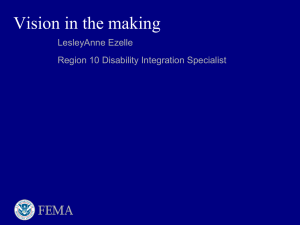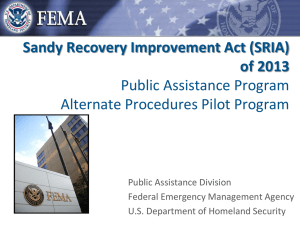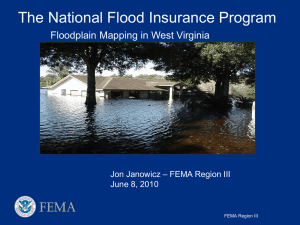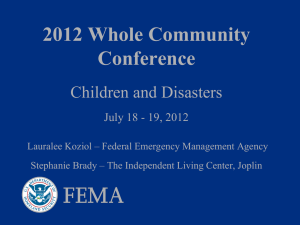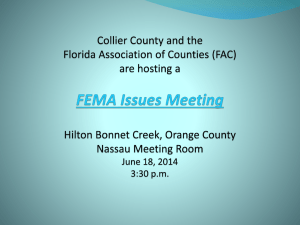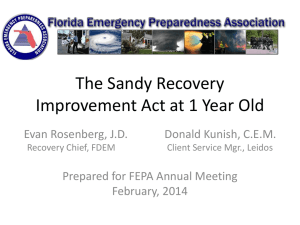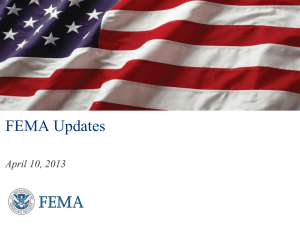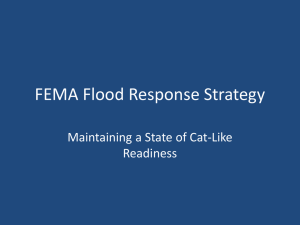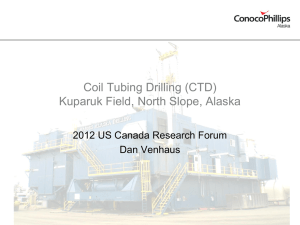Recent Changes to the Stafford Act
advertisement
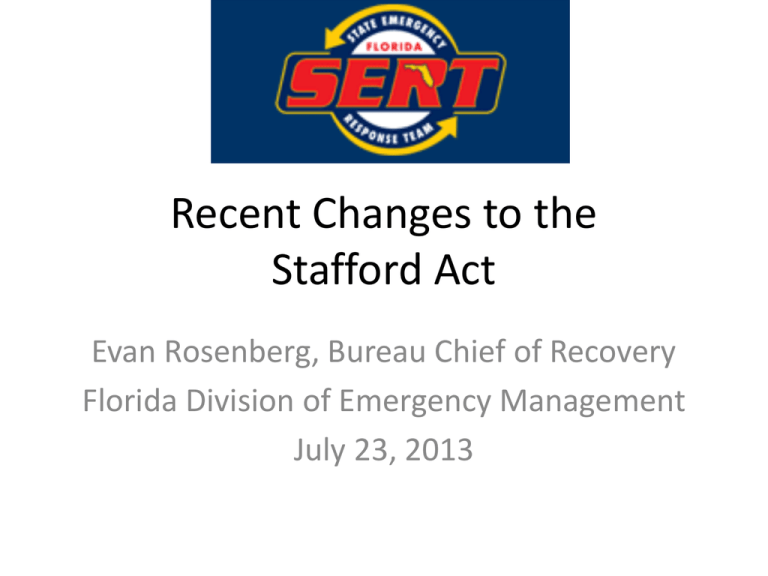
Recent Changes to the Stafford Act Evan Rosenberg, Bureau Chief of Recovery Florida Division of Emergency Management July 23, 2013 Recent Changes • Sandy Recovery Improvement Act of 2013 (P.L. 113-2) signed by President Obama on January 29, 2013 – Originally intended to simply provide financing for the Disaster Relief Fund after Superstorm Sandy, another pending bill to amend the Stafford Act was appended on at the last minute Generally Speaking… • The amendments authorized $5.4 Billion to replenish the Disaster Relief Fund (nonSandy), and $6.1 Billion specifically earmarked for Sandy recovery – Includes $3 million earmarked for the DHS-OIG to enlarge the scope of their investigations Generally Speaking… (ctd.) • Additionally, the amendments add provisions to the Stafford Act in a number of key areas: – PA Assistance Alternative Procedures, – Debris Management Alternative Procedures, – Emergency Work Labor Procedures, – Dispute Resolution Procedures, – Individual Assistance Procedures, and – Hazard Mitigation Alternative Procedures Part I - PA Alternative Procedures Should I Estimate Costs or Seek Actual Cost Reimbursement? PA Alternative Procedures • The PA Alternative Procedures “package” consists of one required part, with 5 optional features that can be added as desired: – Required: Subgrants based on fixed estimates – Optional Features: • Consolidation of an applicant’s subgrants (projects), • FEMA validation of subgrantee provided estimates, • Review of estimates by an expert panel for projects with federal share ≥ $5 million • Elimination of “penalty” for alternate projects, • Eligible uses of excess funds by the subgrantee PA Alternative Procedures (ctd.) • Fixed Estimate of Costs for Large Project Permanent Work Grants – Now – Large Projects are backed up by receipts & invoices; overage goes back to FEMA – New Procedure – If the applicant chooses the PA Alternate Procedures “package,” large Projects will be reimbursed on the basis of fixed estimates • Underage not paid by FEMA, • Overage may be kept by the applicant in certain circumstances PA Alternative Procedures (ctd.) • Fixed Estimates (ctd.) – FEMA, State and Locals must all agree on the eligible disaster damage & the scope of work • Within 9 months of declaration date unless extended • Scope of work must include D.A.C. up front! – Subgrantee must still document actual costs & provide sufficient documentation that the scope of work was completed • Federal procurement, environmental, historic preservation, etc… rules still apply Option 1 – Project Consolidation • Consolidation of Projects (Large, Cat C-G only) – Now – Projects are pretty much stand-alone – New Procedure – FEMA intends to write projects by consolidating scopes of work from what would have been individual projects under the existing PA rules. • This is designed to allow overages on components of the consolidated project to offset underages on other components. • Projects to be bundled can be chosen on a case-by-case basis (ex: leave a large project with anticipated environmental issues out of the consolidated project) Options 2 & 3 – Validation & Review • Validation & Review of Cost Estimates – Now – Applicant develops cost estimates; FEMA conducts separate analysis and has the option to deobligate based on “reasonableness” standard – New Procedure – • Validation: Allows (but does not require) FEMA to accept mutually agreed upon certified cost estimates prepared by applicant’s licensed Engineers, and • Review: Applicants may request to use a FEMA-funded, independent validation of project estimates for Permanent Work projects with an estimated Federal share ≥ $5 million (binding on FEMA) Option 4 – Alternate Projects • Elimination of “Penalty” for Alternate Projects – Now – Sections 406(c)(1) and 406(c)(2) require a reduction of the otherwise-eligible federal share for alternate projects • For governmental entities, reduction is 100% to 90% • For PNP’s, reduction is 100% to 75% – New Procedure – • Reduction is eliminated, and alternate projects will be paid at 100% of the otherwise-eligible federal share • Note that FEMA still must give pre-approval for alternate projects! Option 5 – Keeping Excess Funds • Eligible Uses of Excess Funds – Now – Subgrantees must return excess funds not utilized in completing the approved scope of work – New Procedure – When the cost of work to complete a PW is less than the fixed estimate, the Subgrantee may use the excess funds for PA program-related purposes Keeping Excess Funds (ctd.) • Eligible Uses of Excess Funds (ctd.) – Allowable Uses: • Cost-effective hazard mitigation activities • Activities that improve future PA permanent work operations (training, planning, etc…) – Mechanism: • Subgrantee notifies the State in writing of the intent to use excess funds, including scope of work and timeline • FEMA then writes up a new PW for the use of excess funds – FEMA must obligate this new PW through usual channels Keeping Excess Funds (ctd.) • Eligible Uses of Excess Funds (ctd.) – Uses that are NOT Allowed: • Payment of the non-federal share of PA Program subgrants, or similar for other federal grants, • Restoring or replacing facilities that are otherwise ineligible for PA Program funding, • Restoring or replacing a facility not damaged in the declared disaster (except for Hazard Mitigation), • Operating expenses (increased or otherwise), • Cost overruns on other PA Program subgrants, • Payment of municipal or corporate debts, • Incorporation into the municipality’s General Fund Not Part of PA Alternate Procedures (But Still Worth Noting!) • Small Projects – Now – Small Project threshold = $67,500 – New Procedure – FEMA tasked with reporting to Congress on whether the small project threshold should be raised • BUT… the current amendments also encourage the practice of bundling (“consolidating”) projects together on Permanent Work PW’s whenever practicable Part II - Debris Management Alternate Procedures Pilot Program to Incentivize Speedy & Planned Debris Management Incentives for Local Debris Management Planning • Incentivizing a Local Debris Management Plan – Now – no incentives – New Procedure – If a subgrantee has a “FEMAreviewed” debris management plan at the time of an event, FEMA will provide a one-time incentive of an additional 2% federal cost share adjustment • The additional 2% only applies to debris removal work completed within 90 days of the start of the incident period. Revenue from Recycling • Encouraging Recycling – Now – any revenue stream coming in from the grant mechanism will reduce the amount of the grant – New Procedure – revenue streams from recycling debris will not reduce the amount of the grant • Note: you cannot claim costs of the recycling program under any category of PA Revenue from Recycling (ctd.) • So, what can we use recycling revenues for? – Subgrantees who develop revenue from a recycling stream may keep and use that revenue on the following approved purposes: • To meet your non-federal cost share for Cat. A activities, • To develop disaster preparedness plans, programs & capabilities, • To conduct mitigation activities to reduce future risk from a disaster, or • To improve future debris removal operations and planning Sliding Scale for Speedy Work • Adoption of a Sliding-Scale for Cost-Share – Now – Cost-share is established for the disaster by FEMA, and is (generally) constant across all categories of work – New Procedure – FEMA will be allowed to incentivize speedy and complete debris removal by implementing a sliding-scale for the Federal share for Category A work Sliding Scale for Speedy Work (ctd.) • Sliding Scale – For debris removal completed within the following timeframes, the federal cost share will be: – 0 days to 30 days – 31 days to 90 days – 91 days to 180 days 85% federal cost share 80% federal cost share 75% federal cost share PART III – Other Provisions Other Provisions to Make Recovery Better (?) Emergency Work Labor Procedures • Emergency Protective Measures Force Account Labor – Now • Permanent Work – RT and OT are eligible • Emergency Work – Only OT is generally eligible – New Procedure • Permanent Work – RT and OT are eligible • Emergency Work – RT and OT are generally eligible – Exception – the employee must not be performing their regular force account job functions in order for the RT to be eligible Dispute Resolution Procedures • Implements a Dispute Resolution Process – Now – first appeal (R-IV), second appeal (HQ) – New Procedure – Applicants will have the option of going to second appeal, or utilizing an independent arbitration review panel, when: • The amount in dispute is at least $1,000,000.00, • The project at issue has a non-federal share, and • The first appeal is complete. Dispute Resolution Procedures (ctd.) • Important points about the new Arbitration Review Panels: – The review panels may only consider evidence contained in the record from the first appeal, • The review panels may only set aside a FEMA determination that is found to be arbitrary, capricious, an abuse of discretion , or otherwise not in accordance with law, and • If the review panel determines a claim to be frivolous, the review panel may impose costs against the applicant. Individual Assistance Procedures • Revision of Factors Leading to an IA Declaration – Now – No set guidance codified in law or policy – New Procedure – FEMA is required to conduct a Rulemaking process to review and revise the factors to be considered when evaluating whether or not to implement IA in a disaster • Does this mean a hard-line threshold is coming (like in PA)? We don’t know… IA Procedures (ctd.) • Other IA Procedures Being Amended: – Child care expenses are explicitly affirmed as an eligible & reimbursable expense as part of Other Needs Assistance – Provides FEMA explicit authority to lease and repair rental units for use as direct temporary housing Hazard Mitigation Alternate Procedures • Changes the Availability of Hazard Mitigation Funds – Now – no advancement of HMGP funds to the State – New Procedure – up to 25% of the estimated HMGP funding may be advanced to the State before eligible costs are incurred Hazard Mitigation Procedures (ctd.) • Development of Streamlined Review Procedures – Now – No explicit statutory authority for streamlined environmental and/or historic preservation analysis – New Procedure – Provides a clear statutory goal that such reviews be performed by the most expedient process allowed by law • Also provides funding for additional review staff! Conclusion Are we there yet? So, what Does this Mean to Us? • FEMA has put guidance forward for PA and Debris Management Alternative Procedures – For the PA Alternative Procedures, go to: http://www.fema.gov/library/resultSearchTitle.do ;jsessionid=2F709461ACB4AF727D22C5CB7F746E BD.WorkerPublic2 – For the Debris Management Alternative Procedures, go to: http://www.fema.gov/library/viewRecord.do?id=7 776 Final Thoughts • Time will tell if these changes are good for State and local governments. Goals for these amendments are to: – Reduce the costs to the Federal government of providing assistance, and: • Increase flexibility in the provision of assistance, • Expedite the provision of assistance, and • Provide financial incentives and disincentives for the timely and cost-effective completion of projects with assistance
